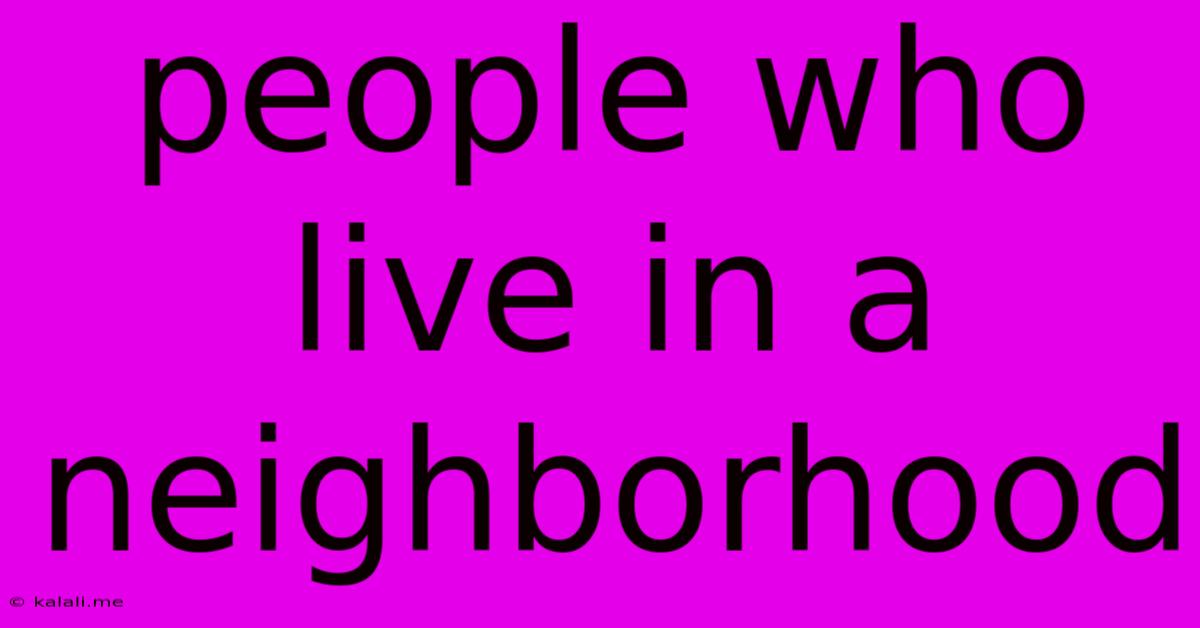People Who Live In A Neighborhood
Kalali
Jun 08, 2025 · 3 min read

Table of Contents
The Heart of the Neighborhood: Understanding the People Who Live There
Meta Description: Explore the diverse tapestry of people who make up a neighborhood, from their shared experiences to individual stories, and how understanding this dynamic shapes community life and strengthens social bonds. Discover the key factors influencing neighborhood demographics and the impact of community on individual well-being.
Neighborhoods. The word conjures up images of friendly faces, familiar streets, and a sense of belonging. But beyond the picture-postcard ideal lies a complex web of human interactions, individual stories, and shared experiences that define the true heart of any community. Understanding the people who live in a neighborhood is crucial, not just for fostering a stronger sense of community, but also for understanding the broader societal fabric.
The Diverse Tapestry of Neighborhood Life
A neighborhood isn't just a collection of houses; it's a microcosm of society. Within its boundaries, you'll find people from all walks of life: young families, retirees, single professionals, students, artists, and entrepreneurs. This diversity contributes to a rich and vibrant community, fostering creativity and understanding. However, understanding this diversity requires more than just acknowledging its presence; it requires actively engaging with the different perspectives and experiences that shape the neighborhood's character.
Consider the following factors that contribute to the unique demographic makeup of a neighborhood:
- Housing costs: The price of housing significantly influences who can afford to live in a particular area, creating a natural stratification of income levels.
- Proximity to work and amenities: Commuting times and access to essential services like schools, hospitals, and grocery stores are major factors in choosing a neighborhood.
- Local culture and atmosphere: Some neighborhoods attract specific demographics based on their cultural offerings, such as vibrant arts scenes, family-friendly parks, or active nightlife.
- Historical context: The history of a neighborhood often shapes its current demographics, with long-standing communities retaining a sense of identity and tradition.
Building Bridges: Fostering a Stronger Community
Understanding the people who make up your neighborhood is the first step towards building a stronger, more cohesive community. This involves more than just knowing your neighbors' names; it's about actively engaging in community events, participating in local initiatives, and fostering open communication.
Here are some ways to connect with your neighbors and build a stronger sense of community:
- Attend neighborhood meetings and events: These gatherings provide opportunities to meet fellow residents, share ideas, and participate in decision-making processes.
- Organize neighborhood initiatives: From community gardens to neighborhood watch programs, collaborative projects can foster a sense of shared purpose and responsibility.
- Engage in casual interactions: A simple wave, a friendly conversation, or offering help to a neighbor can go a long way in building rapport and fostering a sense of belonging.
- Support local businesses: Patronizing local shops and restaurants helps to sustain the economic vitality of the neighborhood and strengthens community ties.
The Impact of Community on Individual Well-being
The people in our neighborhood significantly impact our individual well-being. Strong community bonds are linked to improved mental and physical health, increased social support, and a greater sense of security. Feeling connected to your neighbors provides a sense of belonging and reduces feelings of isolation, particularly for vulnerable populations like the elderly or those living alone.
A thriving neighborhood is more than just a collection of houses; it's a network of individuals supporting one another, creating a sense of shared identity, and building a better place to live for everyone. By understanding the diverse tapestry of lives within our neighborhoods, we can strengthen community bonds, improve individual well-being, and create truly vibrant and thriving places to call home.
Latest Posts
Latest Posts
-
How Do You Vent A Portable Air Conditioner
Jun 08, 2025
-
Integration Procedure Pass Data From Dataraptor Out
Jun 08, 2025
-
If My Car Calls For 0w20 Can I Use 5w20
Jun 08, 2025
-
Liftmaster Garage Door Remote Control Not Working
Jun 08, 2025
-
How Do You Remove Glue From Wood
Jun 08, 2025
Related Post
Thank you for visiting our website which covers about People Who Live In A Neighborhood . We hope the information provided has been useful to you. Feel free to contact us if you have any questions or need further assistance. See you next time and don't miss to bookmark.